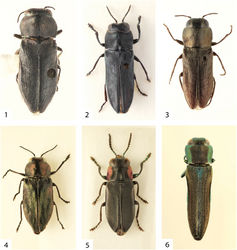Anthaxita
| Notice: | This page is derived from the original publication listed below, whose author(s) should always be credited. Further contributors may edit and improve the content of this page and, consequently, need to be credited as well (see page history). Any assessment of factual correctness requires a careful review of the original article as well as of subsequent contributions.
If you are uncertain whether your planned contribution is correct or not, we suggest that you use the associated discussion page instead of editing the page directly. This page should be cited as follows (rationale):
Citation formats to copy and paste
BibTeX: @article{Bílý2013ZooKeys304, RIS/ Endnote: TY - JOUR Wikipedia/ Citizendium: <ref name="Bílý2013ZooKeys304">{{Citation See also the citation download page at the journal. |
Ordo: Coleoptera
Familia: Buprestidae
Name
Anthaxita Bílý, 2013 gen. n. – Wikispecies link – ZooBank link – Pensoft Profile
Type-species
Anthaxita peruviana gen. n., sp. n. by present designation.
Description
Medium-sized (5.4 mm), dark, with silky lustre, Anthaxia-like, subparallel (Fig. 1); dorsal surface asetose, ventral surface with sparse, white, recumbent pubescence.
Head large, as wide as anterior pronotal margin; frons flat, vertex almost 3 times as wide as width of eye; antennae very short reaching anterior third of pronotal margins when laid alongside; clypeus short, transverse, anterior margin weakly emarginate.
Pronotum regularly convex, lateroposterior depressions and “agriloid” carina missing; lateral pronotal carina short, reaching posterior third of pronotal margin; posterior pronotal margin (covered by elytral base) serrate; posterior pronotal angles obtuse-angled; prescutellar pit and basal tubercles missing; pronotal sculpture very fine, homogeneous, consisting of very fine polygonal cells. Scutellum cordiform, 1.5 times as long as wide (Fig. 32), resembling the scutellum of the click-beetles of the subfamily Cardiophorinae.
Elytra about twice as long as wide, subparallel at anterior two thirds, regularly tapering at posterior third; elytral apices narrowly rounded, very finely serrate; elytral epipleura very narrow, narrowing posteriorly, reaching posterior fourth of elytral margin; subhumeral carina well defined; humeral swellings small; basal, elytral, transverse depression of elytra deep, narrow, reaching scutellum but interrupted by small tubercle near humeri; elytral sculpture very fine, homogeneous.
Ventral surface lustrous, metepisterna with patch of cream-white pubescence; prosternum weakly convex, anterior margin straight; prosternal process flat, slightly tapering posteriorly, not widened behind procoxae. Suture between abdominal ventrites 1–2 missing; anal tergite concave, posterior margin obtusely rounded, not serrate; anal ventrite slightly convex with obtusely rounded and finely serrate posterior margin. Legs short, stout, tarsi much shorter then tibiae. Tarsal claws strongly curved, robust, slightly enlarged at base.
Etymology
The genus name Anthaxita gen. n. (feminine) indicates the strong similarity to the genus Anthaxia.
Differential diagnosis
Except for the characters mentioned in the key, the genus Anthaxita gen. n. differs from other Neotropical genera of Anthaxiina by the combination of the following characters: pubescence of ventral surface, very wide vertex, very fine sculpture of pronotum and elytra, serrate posterior margin of pronotum, shortened elytral epipleura, missing suture between abdominal ventrites 1–2, short lateral pronotal carina, posteriorly acuminate prosternal process, concave anal tergite (pygidium), narrowly attenuate elytral apex and by the absence of the “agriloid” carina, lateroposterior pronotal depressions, and prescutellar pit. The male is unknown.
Distribution
Peru.
Note
Among all Neotropical Anthaxiini,the genus Anthaxita gen. n. is most similar to the Holoarctic species of Anthaxia, particularly to the subgenus Melanthaxia Rikhter, 1949.
Original Description
- Bílý, S; 2013: A study on the Neotropical Anthaxiini (Coleoptera, Buprestidae, Buprestinae) ZooKeys, 304: 17-47. doi
Images
|

